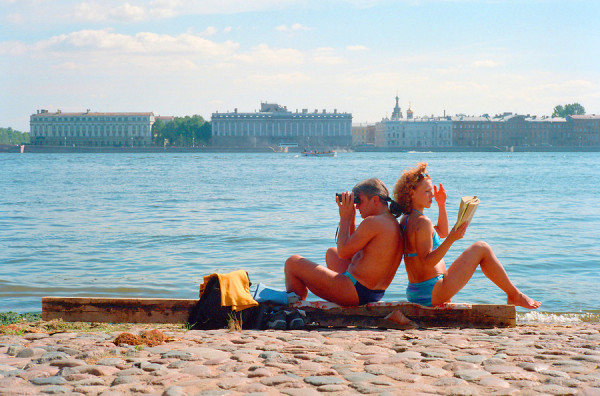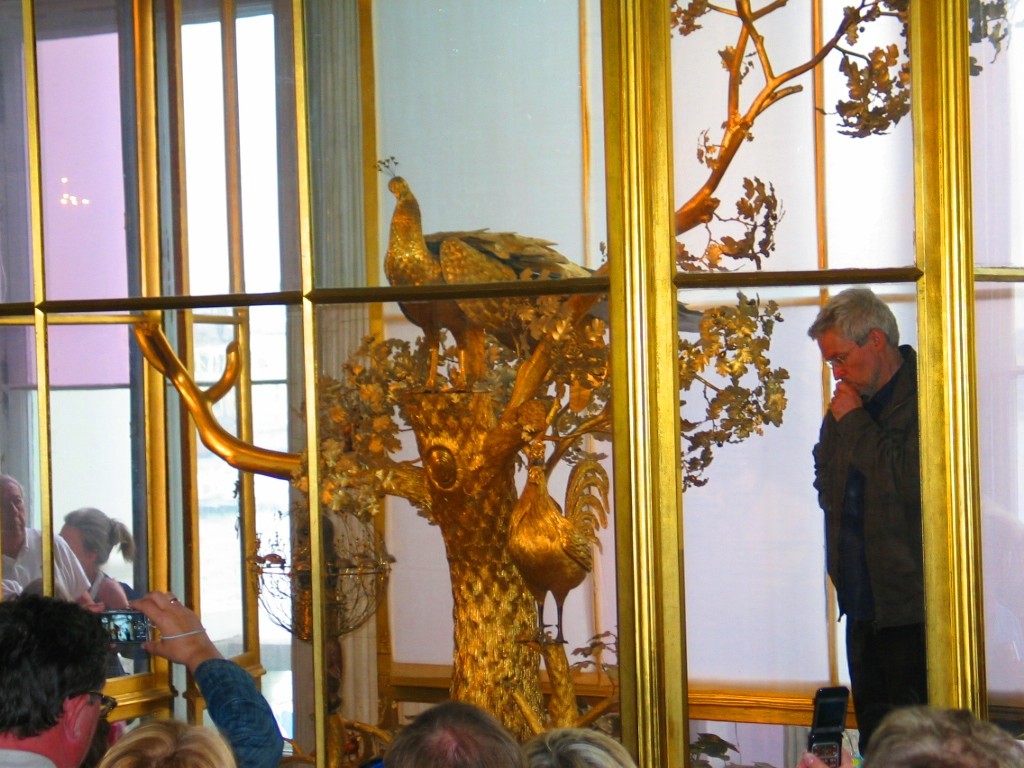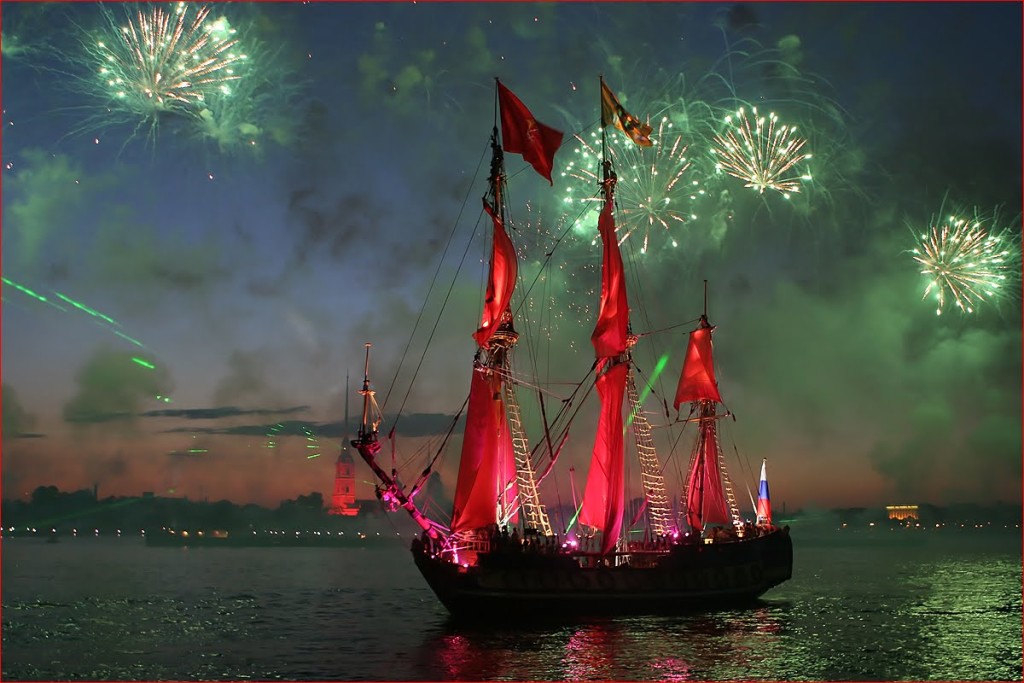Pearly dusk lingers for hours along the horizon and then soon as not twilight begins to merge into the yellows, corals and pinks of dawn, reflecting in the river and maze of canals. The mid-summer “White Nights” is a magical time to experience fabled St. Petersburg, the home of royalty, Romanovs and revolution.
One summer vacation my mother presented me with a copy of Nicholas and Alexandra for my 13th birthday. Initially intimidated by the voluminous tome, by the third chapter my interest in horseback riding and swimming waned as I was transported to another realm: the resplendent halls of the Winter Palace, Alexandra’s mauve boudoir, the imperial yacht’s sunny decks, and the streets of St. Petersburg, seething with royalty and revolution. When I reached the final chapter and the family was summarily executed, I cried in my bunk bed. In the following years I devoured endless books about Russia and surprised my history teacher with an understanding of the minutiae of the Russian Revolution.
With my imagination impregnated by Russia, it was destined that I would later visit the USSR numerous times during the Gorbechav years; several times on anti-Nuclear Peace Walks. On my most recent visit, the timing was fortuitous as it fell during the City Day Celebrations and a rare heat wave that had the denizens out strolling in shorts and halter tops on the blocked off Nevsky Prospekt, lounging in the parks, and sunning at the Fortress beach on the banks of Neva River.
It comes as a surprise to many visitors to learn that Boston, New York and Philadelphia are older than St. Petersburg: an astonishing vision of palaces, broad boulevards, canals, and culture founded a mere 310 years ago by Tsar Peter the Great on 42 swampy islands in the Neva River. Despite all that this “Venice of the North” has endured – the thousands who died during its construction; devastating floods; bloody court intrigues; uprisings and Revolution; Stalinist purges; a 900-day Nazi siege; and a McDonalds invasion – perhaps no other city has engendered such a profusion of creative luminaries: Balanchine, Diagilev, Dostoyevsky, Eisenstein, Gogol, Pavlova, Prokofiev, Pushkin, Rimsky-Korsakov, Stravinsky, Tchaikovsky, Sergei Eisenstein, Rudolf Nureyev, and Vaslav Nijinsky. With over 100 museums, glorious churches and palaces, parks, monuments and ballet and music performances, it is hard to not be enthralled by Russia’s cultural capital.
On the first day in the city my fellow traveler, Rob, and I took advantage of the stellar weather and minimal traffic by renting bikes to see neighborhoods otherwise well-off the tourist beat. I was particularly eager to visit the Cathedral in the Peter and Paul Fortress (its golden spire the city’s landmark) the resting place of Romanovs, including the remains of Nicholas, Alexandra, their five children and three servants that were only recently discovered and identified. Odd, the sense of relief and completion I felt in reading their names etched in white marble.
Well into the endless evening we pedaled along the numerous canals past the gilt dome of St. Isaac’s Cathedral (the world’s third largest) and the onion-domed Church of the Savior of the Blood, where Alexander II‘s carriage was blown up by anarchists in 1881. Further along the Griboyedoya Canal is the delightful golden-winged Griffin Bridge; touch its paw, make a wish and walk across.
A Thousand Rooms With a View
The next day we toured the opulent rooms of the Yusupov Palace the highlights being the lavish miniature theater that still holds regular performances, and the bachelor’s apartment where Rasputin met his demise at the hands of the very gay Felix Yusupov and several Romanov royals. Though he was poisoned, shot and thrown into the Neva, the autopsy showed that Rasputin had actually died of drowning.
With over 100 museums and palaces in the city you can’t possibly see them all, but topping the short list is, of course, the Hermitage. Built between 1754 and 1762 on the Neva’s bank, the Winter Palace was intended for Peter’s daughter Elisabeth, but upon her death Catherine the Great moved in, commissioning adjoining buildings for her ever-growing art collection. Today the green and white palace complex contains 1,057 rooms, among them the Malachite Room, and over three million art pieces spanning from Greek and Roman to Rubens and Gauguin.
While there, I was thrilled to see the newly restored Renoir masterpieces, “Man on a Staircase” and “Woman on a Staircase”, commissioned in 1876 by French publisher Georges Charpentier, an early admirer of Renoir. A German bought the pair from Charpentier’s heirs, which were confiscated to Russia after the war. Last displayed in 1995, their luster was hidden under layers of dirt and darkened lacquer, but since the restoration, art lovers can once again view these fine Renoirs in all their glory.
Though the Hermitage contains many “must sees,” make sure to check out the Peacock Clock in the Pavilion Hall. Each Wednesday at 5 P.M. this magnificent gilded clock created by celebrated 18th Century English clockmaker, James Cox, is wound up and the action begins. The owl in a cage blinks its eyes and turns its head, a rooster crows, and the gilded peacock sitting on a golden branch spreads its tail, the gold feathers raise upright, and the whole bird rotates.
It would be downright negligent to visit St. Petersburg and not attend a performance at the Mariinski Theater, formerly the Kirov. I’ve never seen Swan Lake, so we bought tickets and loved the production. I suspect I would have enjoyed anything I would have seen there though.
White Nights
The mid-summer “White Nights” – early June through mid-July – is a magical time to experience St. Petersburg. The sun doesn’t set until 11:00 pm or so. Pearl twilight lingers on then merges into the yellows and corals of dawn. Gauging bedtime at this time of year can be problematic, so all hotels have blackout curtains. We planned to stay up late to take a boat ride to see the palaces all lit up and the bridges opening at 1:30 A.M. to let the ships pass through.
As long as I have a power bar or trail mix in my day pack I can pass the day without a real meal, but not Rob who compelled me now and then to actually sit down for a four-square meal in a restaurant. Walking back from the Mariinski Theater Rob pulled me into a restaurant with Georgia Kitchen written above the door. It turned out to be a wonderful Caucus dining experience: Khachapuri tarkunit (stuffed herb and cheese bread), Badrijani Nigvzit, Eggplants seasoned with ground walnuts, pomegranates and spices, while Rob, who is a ‘shroomer”, chose soko, wild mushrooms seasoned with spices and herbs. For the main course we both chose Satsivi, chicken in a delicious cream walnut sauce.
The famous Sunday Jazz Brunch at the Grand Hotel Europe is a venerable St. Petersburg institution dating back before the Revolution and where royalty, movie stars, U.S. presidents and heads-of-state have all dined, and if you can afford it, don’t miss it. But at $100 starve yourself beforehand and get your money’s worth at the fabulous buffet featuring caviar-topped eggs, smoked salmon, king prawns, oysters, sushi, and dozens of meats, salads, fruits, desserts, and of course endless champagne and caviar. You can spend all afternoon in this superb Art Nouveau gem eating, dancing, strolling around the hotel, then return and gorging some more.
On our final morning in St. Petersburg we traveled south from the city to visit the delightfully restrained – relatively speaking – neo-classical Pavlovsk Palace designed by Scottish architect Charles Cameron and commissioned by Maria Feodorovna, wife of Tsar Paul I. A wonderful book, Pavlovsk: Life of a Russian Palace, written by Suzanne Massie (who co-wrote Nicholas and Alexandra and several other books about Russia) inspired me to visit this place; one that is often over-looked by tourists short of time. We hired a horse-drawn carriage for a ride around the park – one of the largest in Europe – done in the “English Style.”
A few miles away we visited Tsarskoe Selo, the country residense and gardens of the Tsars and their families. The outlandish rococo Catherine Palace with its 1000-foot façade gilded with over 100 kilograms of gold, and filled with over 20,000 decorative objects and art. What makes the grandeur of both these palaces all the more astonishing is that the retreating Germans reduced them to charred rubble. All the glorious stucco, mosaics, carvings and gilt work that you now see was painstakingly recreated in the decades after the war. The singular, dazzling Amber Room looted by the Nazis and never recovered was only completed six years ago, just in time for the 300th anniversary of the city.
That afternoon we caught the hydrofoil and whooshed down the Neva to Peterhoff, Peter the Great’s fantastic estate on the Gulf of Finland, famous for its Grand Cascade Fountains and trick water gardens. Then we spent an hour wandering the extensive grounds. Frankly, all this opulence makes a sentient soul realize why a Revolution was needed in the first place, and equally curious as to why the Soviets felt compelled to invest much of their limited post-war resources into recreating their reviled imperial past. I guess it’s one of those love/hate relationships that you just can’t let go of.
While increased personal freedoms for minorities and entrepreneurial initiatives are certainly a boon for many in the new Russia, the life of average person in the countryside has changed little, and the Soviet social safety net has been irrevocably torn leaving the poor and elderly to fend for themselves. It was disconcerting to see numerous babushkas “selling” clusters of lilacs; I watched people give them money but never take the fragrant flowers. Everywhere, the parks and palace grounds were abloom with white, lavender and violet buds that set the dominant floral note wafting over the city. For me, the scent of lilacs will forever conjure up the grand and marvelous city of St. Petersburg.




